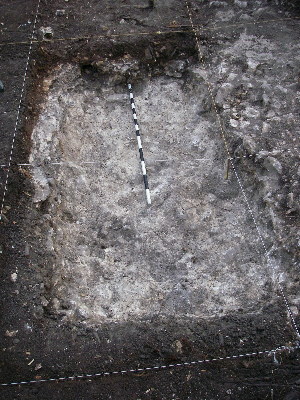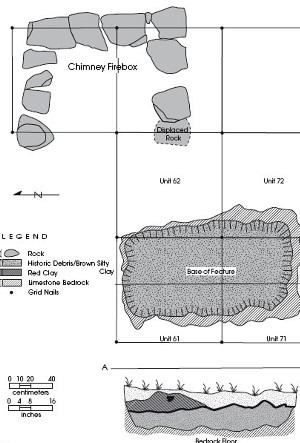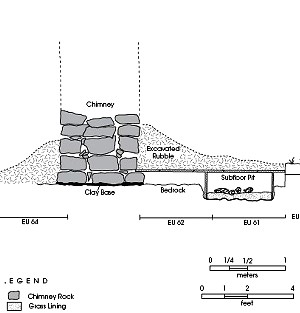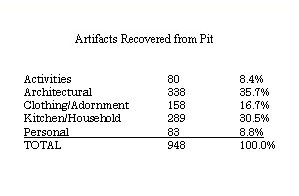Archeologists uncovered an anomaly in front of the fireplace firebox which we are interpreting as an underground storage pit. The photographs above and at top right show the completely excavated pit feature. Roughly oval in shape, the pit had been dug down into weathered but hard bedrock limestone.
This feature was an irregular oval shape measuring about 2.5 to 3.5 ft wide and 5.6 ft long. It was dug down about 16 inches below the original ground surface. We believe this pit functioned as a subfloor food storage pit; such pits were common in the Southern states and were usually called potato cellars or root cellars.
As shown in the plan and profile, the pit which was located directly in front of the fireplace but was offset to one side. Subfloor pits like this one are common in dwellings that housed plantation slaves, and they served a variety of purposes. In 2007, Patricia Samford published a book called Subfloor Pits and the Archaeology of Slavery in Colonial Virginia. She identifies the three most common functions of subfloor pits in slave dwellings as: (1) pits used to store personal possessions within a crowded dwelling (i.e., an underground footlocker); (2) pits used to conceal contraband, especially items associated with ritual beliefs that were forbidden, from plantation owners and overseers (sometimes called “hidey holes”); and (3) pits used to store root foods, generally called a “potato cellar.” For the subfloor pit in the Williams house, we believe that the potato cellar explanation makes the most sense.
The use of potato cellar pits is well documented across the South, in black and white households. Potato cellars were often located near hearths and used to store various vegetables such as corn, white potatoes, and squash, but the most common food stored in them was sweet potatoes. We know that the Williamses grew sweet potatoes because charred fragments of this important root food were recovered. A former slave and famous abolitionist wrote about potato cellars in his book, Life and Times of Frederick Douglass. He recalled “…the hole so strangely dug in front of the fire-place, beneath which grandmamma placed her sweet potatoes to keep them from frost in the winter…” Echoing the use of underground pits for storing perishable foods, our oral history research demonstrates that people in central Texas used potato cellars well into the twentieth century. Lillie Grant, who was born in 1923 and raised on “The Prairie” near Buda, Texas, remembered how potatoes were stored in a cellar-like area under the floorboards of the pantry because it was cooler there. In her interview with Dr. Maria Franklin for this project, she noted:
“…We had a big pantry with food in it like potatoes and things like that and onions. It was cool. You know, the houses there were built up off the ground and it made the vegetables cool; we put our potatoes underneath there.”
Assuming that this feature did function as a potato cellar, two factors may have dictated the pit’s location near the fireplace. One is that this is the logical area for easy access to a subfloor pit. The front of the fireplace was a communal area where the family gathered to eat meals and socialize. Except perhaps for a table and chairs, this central area would have been kept clear and maintained regularly. More permanent furniture such as cabinets and beds would have been along the walls and toward the back of the house, opposite the fireplace. The second factor is that heat provided by the fireplace may have been an important consideration for the underground storage of perishable food items in the wintertime. If the pit were close enough to the chimney, the heat from the fireplace would warm the enclosed house and keep food in the centrally-located potato cellar from freezing.
The drawing at right is a reconstructed profile of the chimney and pit. This interpretation assumes the Williams house had a wooden floor, that the pit sides were lined with wood, and that the pit was accessed through a hinged doorway. The pit bottom would have been lined with grass as a moisture barrier between the bedrock and stored foods.
When the subfloor pit was abandoned as a food storage compartment, it was backfilled with household debris that appears to have come from the trash midden. The fill inside the pit contained the same type of dark organic rich sediment as the midden, and had a comparable density of artifacts, as shown in the list at right.
From a chronological standpoint, many of the artifacts found in the storage pit were manufactured after 1890, and one item is a glass jar lid with a patent date of January 11, 1898 (Patent No. 597,299 issued to John Schies for his “Design for a Jar-Fastening Bar”). The latter artifact indicates that the subfloor pit was not abandoned until 1898 or later, and we think two scenarios are plausible. The Williams family might have purchased an icebox around the turn of the century, at which point they would not have needed the potato cellar and would have backfilled it to prevent animals from making their home inside the hole. The alternative explanation is that the pit was backfilled when the Williams family left the property about 1905. They would have filled in the hole if they intended to use the house as a storage shed or work barn. |
 Excavated storage pit.  |
 Plan and profile views of the subfloor storage pit.  |
| The use of potato cellar pits is well documented across the South, in black and white households. Potato cellars were often located near hearths and used to store various vegetables such as corn, white potatoes, and squash, but the most common food stored in them was sweet potatoes. |
 Reconstructed profile of the house floor, potato cellar, and hearth. This plan assumes the cabin had a wooden floor, and that the pit was originally lined with wood.  |
 List of artifacts recovered from the storage pit. |
|



